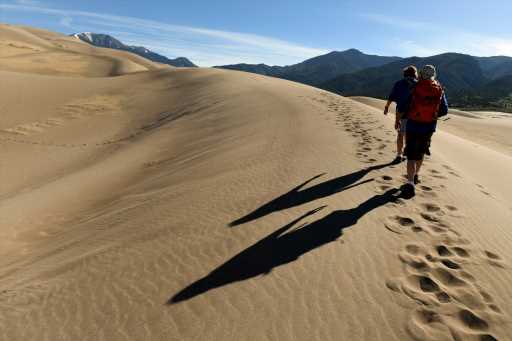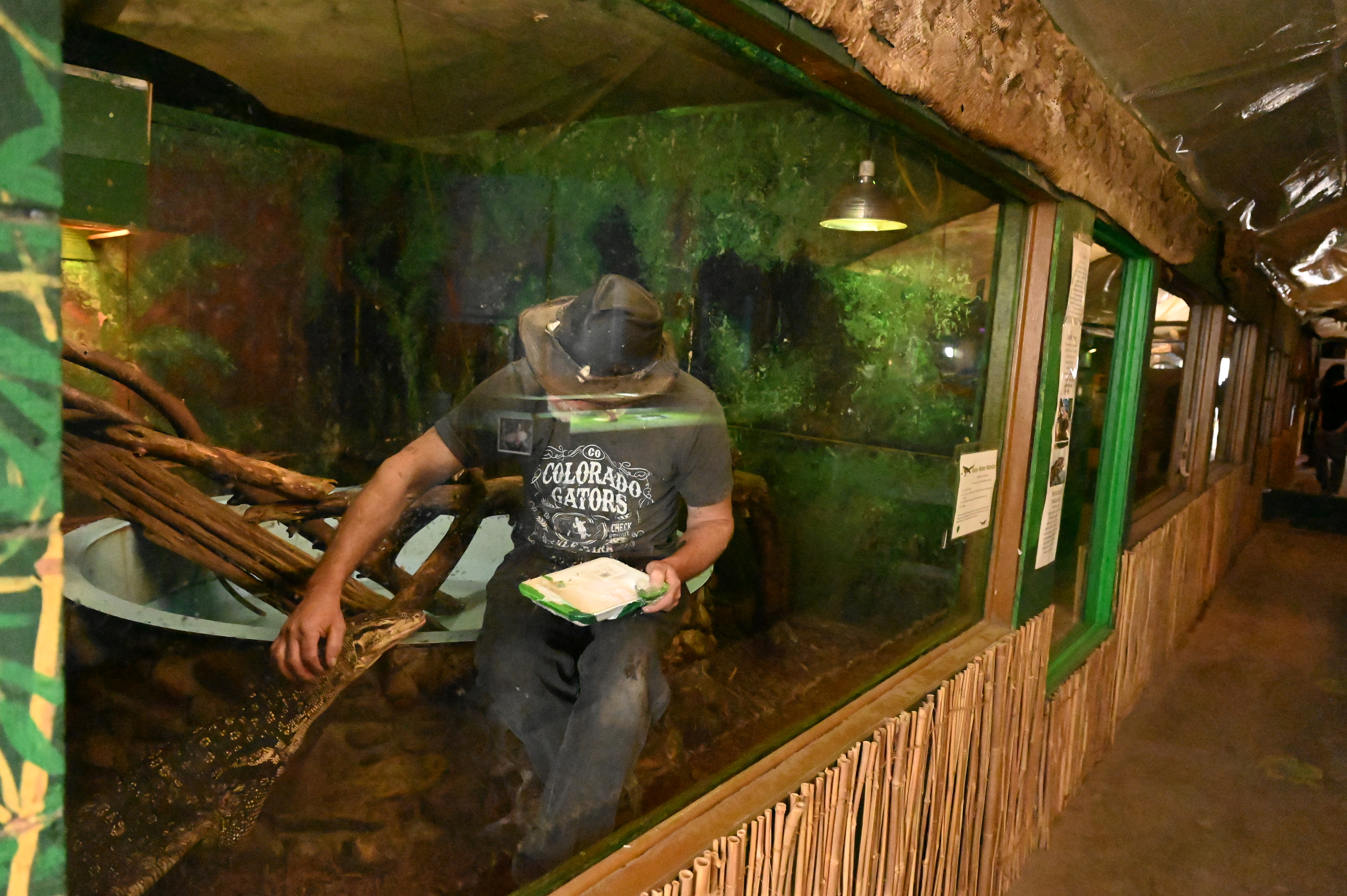
Even native Coloradans might not know the state is home to the largest alpine valley in the world.
The San Luis Valley in southern Colorado, hemmed in on three sides by mountains and the Taos Plateau to the south, was once so remote early settlers developed a unique dialect of Spanish. The oldest settlements in Colorado were founded here, long before wagons bearing “Pikes Peak or Bust” rattled across the Great Plains.
Modern highways ended the isolation, and today the valley and its natural splendor are only a few hours’ drive from the Front Range. From hikes to hot springs to history to UFOs (seriously), there’s nowhere better to work a wide variety of experiences into one road trip. This is your guide to a long weekend in the San Luis Valley.
Day 1 — Colorado can get weird
Since we’re talking superlatives, let’s start with the highest sand dunes in North America, found at Great Sand Dunes National Park and Preserve. Formed over eons by sand blowing against the jagged spine of the Sangre de Cristo Mountains, the dunes rise 750 feet above the valley floor. Lace up your boots or shoes (the sand can get very hot, so leave your flip-flops in the car) and challenge yourself to see how high you can climb. The views from the top are sublime.
If you’re an action sports lover (especially if you snowboard) why not try sandboarding? Sandboards are made with an extra-slick base material and coated with a special wax. You can rent a board at the Oasis campground store just outside the park gate, Spin Drift Sandboard Rentals in Blanca, or Kristi Mountain Sports in Alamosa. If you think a snowboard or the sled you use to zip down hills in winter will work, it won’t. Many have tried.
You can also enjoy an educational presentation from a ranger every morning at the visitor center, and on weekends in the afternoon and evening at the campground amphitheater. The park is also one of the quietest places in Colorado and has little manmade light at night, so is great for stargazing. Admission to the park is $25 per vehicle. If you still haven’t hiked enough, stop at the Zapata Falls trailhead a few miles outside the park for a short hike to a gorgeous cave waterfall.
After your sand dunes adventure, turn right (heading west) on County Road 6 just outside the park entrance, then turn right on Colorado 17, heading north. Some of the oddest places in Colorado are along this road, including the UFO Watchtower. This quirky tourist destination documents decades of UFO sightings, animal mutilations and other excerpts from “The X-Files.” You can also gaze into the dark night — no light pollution here — and imagine we’re not alone in the universe. Admission is $5 per person.
What’s stranger than aliens? How about alligators living in a high mountain desert? Colorado Gators is home to hundreds of reptiles, from snakes to lizards to crocodiles, rescued to live a life of luxury in natural hot spring water. You can even pick up a small gator, if you dare. Admission to Colorado Gators is free for kids 5 and younger and adults older than 79, $10 for ages 6-15, $20 for ages 16-64 and $10 for ages 65-79.
Wrap up the day’s exertions at the Sand Dunes Recreation hot springs (known to locals as the “Hooper Pool”). There’s a large, hot-water swimming pool and the adults-only Greenhouse and its many smaller pools. It’s also a great place to get dinner or cocktails. From Colorado 17 turn east on County Road B (there’s a billboard at the turnoff) and then north on County Road 63. The hot springs will be on the left. Admission is $15, or $10 for ages 3-12. Adults pay $5 more to access the Greenhouse. The pools are closed for cleaning on Thursdays.
Where to stay: There are campgrounds inside Great Sand Dunes National Park and Preserve (reservations are highly recommended). You can camp at the Oasis Campground just outside the park, with both primitive and RV hookup sites. There’s a primitive campground at the aforementioned Zapata Falls and at the hot springs. If you’re looking for a room, head to Alamosa, where you’ll find a robust selection of mostly chain hotels to choose from.
Where to eat: Beer lovers will enjoy San Luis Valley Brewing Co. Try My Brother’s Place, 613 Main St., Alamosa, for the best New York-style pizza around.
Day 2 — Colorado can get old-school
We’re headed south for a train ride.
Another superlative: The Cumbres & Toltec Scenic Railroad is the longest and highest steam railroad in North America, running 64 miles between the towns of Antonito and Chama, N.M. It was built in 1880 to serve the San Juan Mountains silver mines. It was nearly demolished after the mines shut down, but was saved by Colorado and New Mexico in the name of tourism in 1970. Riders today can enjoy classic Rocky Mountain scenery and marvel as the train traverses steep canyons, tunnels and a 137-foot-tall trestle bridge.
There are numerous ride options, from a couple-hour jaunt to an all-day excursion. A dry spring increased the risk of wildfire and delayed trips until July this year (something to keep in mind if you’re planning a 2023 excursion). Fans of Indiana Jones movies might recognize it — the train was used in the opening segment of “Indiana Jones and the Last Crusade.”
If there’s time in your schedule, be sure to take a few minutes to see the oldest church in Colorado just outside Antonito. Our Lady of Guadalupe is a few blocks from the highway at 6633 County Road 13.
Anglers will find great trout fishing south of Antonito along the Conejos River. The river starts high on the Continental Divide and has plenty of public access for fishing along its banks.
Where to stay: If you don’t feel like driving after the train ride, the Steam Train Hotel is a good option nearby, with rooms starting at $119. Another option is the Indiana Jones Bed and Breakfast, which served as the Jones house in the aforementioned movie. Rooms also start at $119.
Campers will find numerous camping options southwest of Antonito along Colorado 17 as the road meanders along the Conejos River into the mountains. The Aspen Glade Campground is located in a lovely stand of aspen along the river. Or you can try the Mogote Campground, also along the river in a pine forest, or the Elk Creek Campground. For sites with RV hookups, visit the Conejos River Campground.
Where to eat: Antonito isn’t exactly the culinary capital of Colorado, but the scenic train serves food at its halfway stop in the wilderness, Osier Station. You can also soak in the flavor of this Southwestern town at Dos Hermanas, 435 Main St., Antonito, for Mexican fare and steaks.
Day 3 — Colorado can get radical
We hope you brought hiking boots, a mountain bike or rock climbing gear with you, because next we’re headed into canyon country.
Penitente Canyon is a hidden Colorado gem, with a large network of lovely canyons, scenic hiking trails and mountain-biking routes that will remind you of Moab, albeit on a smaller scale. Head north on U.S. 285, then west on U.S. 160 to the quaint town of Del Norte. Once a sleepy hamlet with few amenities, the town of 1,500 has seen a renaissance, with several restaurant options, a robust trail network and even a water park on the Rio Grande with a play wave for tubing and deep eddies for swimming.
Head north on Colorado 112 for a couple miles, watching for the sign directing you to Penitente Canyon, 9 miles after the turnoff. You could spend a couple hours or a couple days exploring the trails or the hundreds of bolted climbing routes. Keep an eye out for the painting of the Virgin of Guadalupe high on a canyon wall, created by friars from the Penitente order. And watch out for rattlesnakes.
If you return to Del Norte and your legs aren’t exhausted, the trail up Lookout Mountain (it has a D painted on it) is a quad-burner with views of the entire valley from the top.
Where to eat: If you like craft beer and pizza, Three Barrel Brewing Co. is the place for you. For comfort food, pastries and cocktails, try The Colorado Grille. If they’re both too busy you’ll find locals’ hangout Carthers Roadhouse a good option, at 505 Spruce St., Del Norte.
Where to stay: A restored historic hotel narrowly saved from the wrecking bell, The Windsor has 20 guest rooms with a Victorian feel, starting at $153. If you brought the dog, the pet-friendly Mellow Moon, a retro motel that received a top-to-bottom renovation, s just a few blocks east of downtown. Rates vary by season.
Campers will find many lovely sites at the Penitente Canyon campground (be sure to bring your own water). Sites are reservable but primitive, with vault toilets and no RV hookups. There are also free pull-off sites along the main dirt roads in the area. RV travelers looking for hookups will need to drive to the nearby town of South Fork, where numerous RV parks line Colorado 160.
Day 4 — Colorado can get spiritual
Since you’re probably heading back to the Front Range, drive north from Del Norte on Colorado 112 until it meets Colorado 17. Head north and you’ll recognize the hamlet of Hooper from the first day. But today our destination is the town of Crestone, one of the quirkiest places in Colorado. It’s about 12 miles east of the highway on County Road T. Against the stunning backdrop of the Sangre de Cristos, Crestone is unique because it was once part of a huge Spanish land grant, and a subsequent landowner famously gave away land to any religious organization that wanted it. Many did, and in the hills around town you’ll find statues and temples and other signs of religions you’ve probably never heard of.
People-watching is a great pastime here, as hippies mingle with Buddhist monks on the streets and in the boutiques, art galleries and shops. If you aren’t in a rush to get home, the South Crestone Trail penetrates the wilderness and offers classic Sangre de Cristo lake views without the steepness these forbidding mountains are known for.
Otherwise take Colorado 17 north to the junction with U.S. 285. Again, if time isn’t pressing, stop for a rejuvenating soak at Joyful Journey Hot Springs, right along the road as you head north toward Poncha Pass and out of the valley.
Where to eat: The Cloud Station, 300 S Cottonwood St., Crestone, offers coffee and light fare, while Our Food is Art, 121 E Galena Ave., Suite B, Crestone, is known for its burgers.
Where to stay: The North Crestone Campground offers a mountain experience just minutes from town. You’ll also find pull-off campsites near the South Crestone trailhead. Turn on Galena Street in town and follow it into the national forest, taking care not to camp on private property.
The Bliss Inn (catching on to the vibe yet?) is a good choice for a night. Rates vary by season and whether you want to stay in a room, a cabin or even a dome. For more choices you’ll want to head to Salida about an hour away, with a wide variety of both chain hotels and locally-owned places. RVers looking for hookups will also need to head to Salida, as there are no such campgrounds in the Crestone area.
Subscribe to our weekly newsletter, The Adventurist, to get outdoors news sent straight to your inbox.
Source: Read Full Article

















